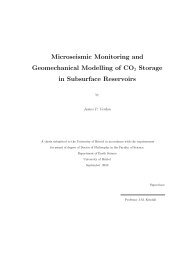The Hudson Bay Lithospheric Experiment - University of Bristol
The Hudson Bay Lithospheric Experiment - University of Bristol
The Hudson Bay Lithospheric Experiment - University of Bristol
Create successful ePaper yourself
Turn your PDF publications into a flip-book with our unique Google optimized e-Paper software.
BASTOW ET AL.: HUBLEalso financially and logistically prohibitive, soinnovative station designs are required.HuBLEbatteriespower regulatorseismometerrecording unitWith the goal <strong>of</strong> constraining better the reasonfor the existence <strong>of</strong> <strong>Hudson</strong> <strong>Bay</strong>, and the Precambrianprocesses that shaped the Canadianshield, the <strong>Hudson</strong> <strong>Bay</strong> <strong>Lithospheric</strong> <strong>Experiment</strong>(HuBLE) was deployed in the summer <strong>of</strong> 2007by personnel from the <strong>University</strong> <strong>of</strong> <strong>Bristol</strong>, incollaboration with the Geological Survey <strong>of</strong>Canada. Nunavut, the homeland <strong>of</strong> the Inuit,is the most sparsely populated region <strong>of</strong>Canada; centres <strong>of</strong> population andinfrastructure are few and farbetween. Wherever possible,seismograph stations weredeployed in safe compounds,such as airports and weatherstations with mains powersupply, and in small communitysettlements in Nunavut.Elsewhere, vast tracts <strong>of</strong> wildernessmeant that remote, independentlypowered recording sites had tobe designed within the financial limitations <strong>of</strong>the project. Transport to these locations was bychartered light aircraft with large tundra tyresto permit landing and take-<strong>of</strong>f from relativelyflat and well-drained glacial deposits (figure 4).Figure 4 shows a completed HuBLE seismographstation in northern <strong>Hudson</strong> <strong>Bay</strong>. Eachsite was equipped with a Güralp CMG-3TDbroadband seismometer, recording at 40 samplesper second. Güralp DCM data recorderswere used at the stations, which were poweredby up to six solar panels (providing 100–140 Wsatellite modem4: HuBLE-UK remote station construction. 20–40 W solar panels on a steel frame recharge3 100 Ah batteries that power the seismometer and recording equipment. <strong>The</strong> GPS antennaprovides continuous accurate timing information. Remote communication with the stations isvia an Iridium satellite modem antenna that was scheduled to operate twice weekly. All fieldequipment is provided by NERC’s seismic equipment pool, SEIS-UK (box 1).‘‘ <strong>The</strong>remoteness <strong>of</strong> theHuBLE network wasa hindrance during thefield campaign, buta blessing for thedata analysispower) and three 100 Ah deep-cycle batteries.Each remote site was equipped with an Iridiumsatellite modem that provided state-<strong>of</strong>-healthdata from the stations. Data retrieved using themodems included: station up-time; digitizer,seismometer, and recorder baud rates; externalhard disk usage; seismometer levelling information;GPS timing information; power supply.Using modems over the Iridium networkprovides pole-to-pole global coverage <strong>of</strong> bothshort message and short data burst services.For the CMG-DCM, this allowed the UK basestation to pull <strong>of</strong>f weekly reports <strong>of</strong> thestate <strong>of</strong> health <strong>of</strong> the remote system.Where problems were diagnosed,’’GPS antennasolar panelslow-latency two-way communicationfor reconfiguration<strong>of</strong> the remote systems wasalso used via simple terminalinteraction. All seismicstation equipment are maintainedby SEIS-UK (see box1), part <strong>of</strong> the Natural EnvironmentResearch Council’s geophysicalequipment facility in Leicester.Where major physical damage to a station(such as cable damage from polar bear attacks)was deduced from the satellite modem data, theservicing team was able to focus its visits onthe problem stations, leaving those operatingsmoothly for the following year. This strategysaved thousands <strong>of</strong> pounds in plane chartertime. Arguably the greatest benefit <strong>of</strong> the satellitemodem system, however, was the abilityto carry out instrument configuration repairsremotely from the UK. In the summers <strong>of</strong> 2008and 2009, for example, two stations suffered1: SEIS-UKSEIS-UK – the UK’s Seismic EquipmentFacility based within the <strong>University</strong> <strong>of</strong>Leicester – is one <strong>of</strong> three nodes that makeup the NERC Geophysical EquipmentFacility (GEF). It maintains a large anddiverse pool <strong>of</strong> seismic instrumentationand associated field equipment for onshorerecording <strong>of</strong> both earthquakes andcontrolled seismic sources. <strong>The</strong> equipmentis available for use free-<strong>of</strong>-charge toUK-based academics via a single loanapplication and subsequent peer review.To date the majority <strong>of</strong> SEIS-UK projectshave been basedoutside the UK, fromEthiopia to <strong>Hudson</strong><strong>Bay</strong>, and haveinvolved substantialcollaboration withnon-UK academics and institutions. <strong>The</strong>facility supports around 12 field projectsa year, providing expertise and trainingin the use <strong>of</strong> the field equipment andassociated data management systems.A processing system for continuousseismic data is fully supported, includingearthquake detection and location.In-house servers with more than 20 Tb <strong>of</strong>storage provide a rapid and convenientroute to data processing while removingthe need for users to maintain expensiveand time-consuming computing facilities<strong>of</strong> their own. SEIS-UK also manages thearchiving <strong>of</strong> data at the IRIS DMC fromwhere data become publicly available.winter power-outages from which they could notrecover. <strong>The</strong> seismometer and recording module(figure 4) had defaulted to different communicationbaud rates but, by logging into the stationremotely, the necessary corrections to therecording parameters were made. An additionalbenefit <strong>of</strong> the satellite modem systems was theability to unlock and reorient seismometers thathad moved significantly or ceased to operate –common in spring-time when shallow permafrostin the Arctic can begin to melt. Carryingout station repairs in this way, as opposed towaiting until the summer service runs, improveddata yield from the experiment by ~20%. <strong>The</strong>cost <strong>of</strong> running the modems, the equivalent <strong>of</strong>two or three transatlantic flights per year, wasexcellent value for money.Scientific insights from CanadaWhile the remoteness <strong>of</strong> the HuBLE networkwas a hindrance during the field campaign, itwas a blessing for the data analysis. <strong>The</strong> quality<strong>of</strong> seismic signals from seismic stations installedso close to basement rock, far away fromA&G 6.23











